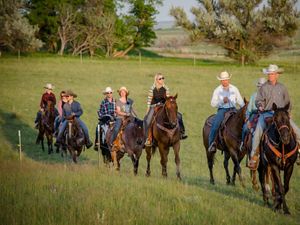What’s in this Season?
North Dakota’s ever-changing seasons serve up immeasurable discoveries in nature. Explore what’s happening in nature this season.
Winter in North Dakota is cold and snowy, but that should not keep you from exploring the outdoors! The trails are quiet and chances are, you may be the only one braving the elements. Embrace the solitude and soak in the mental health benefits the snowy plains and icy ponds have to offer. Bundle up and grab your snowshoes. There is so much going on in nature even on the chilliest days.
Birds
Winter is the best time for birding because there are no leaves on the trees. It makes spotting birds much easier. Although many birds flee North Dakota during the cold winter months, we have some year-round resident birds that you can surely spot around the state, like American Goldfinch, woodpeckers and blue jays. You could even see a Northern shrike, which visits the Dakotas in the winter, returning to northern Canada to nest in the summer. These birds are fierce hunters. Shrikes attack and kill a variety of prey: other birds, mice, lizards, insects; at times even tackling prey larger than themselves (a shrike is about the size of a robin). They kill using their hooked beak; their feet are too weak to kill with grasping talons like hawks and owls. A shrike might not eat its prey immediately. Instead, the bird carries its prey to a larder where it will store food items impaled on barbed wire, thorns, broken twigs, or simply wedged into the fork of two branches. Sighting a shrike could be difficult. In the winter, you might first find evidence of shrike predation—dead sparrows or mice skewered on thorns or barbed wire—before spotting a shrike hunting nearby.
Winter Birds








Occasionally, North Dakota sees snowy owls, visiting all the way from Alaska, Arctic Canada and Greenland. Their plumage reflects their northern home: the birds are white as snow, although females and young birds are barred with black. Their face is always bright white and highlights their brilliant yellow eyes.
Bison
Much of North Dakota’s wildlife either migrates or hibernates to escape the harsh winter. But bison seem to thrive in the cold. They’re animals built for life on the prairie year-round. Visitors to parks and preserves with bison herds enjoy watching bulls, cows and calves mingling together during the summer months. Come late fall, the bulls wander off to form “bachelor bands” and the cows, calves and non-breeding bulls stay together in small herds. These dispersed, separate groups make for fewer animals looking for food in the same place once winter snows make forage hard to find. It’s a good survival strategy.

Bison eat less in the winter. Their metabolism actually slows, allowing them to survive on less forage. Using powerful neck muscles, bison swing their massive heads to push snow out of their way to reach forage beneath. Bison also are good at staying warm. Their summer coat turns dark brown in the fall and develops a dense undercoat of woolly hair that provides insulation during cold weather. Guard hairs provide added protection and are longest on the front half of a bison’s body, covering the head, neck, forelimbs and tall hump above the shoulders. The winter coat on a bull bison can be as much as six inches thick over the hump. During a storm, bison turn and face into the wind, causing these long hairs to lie down against the body, maximizing their insulating ability. Their winter coat insulates so well that a storm’s snow simply accumulates on the animals, unable to be melted by their body heat.
Wildlife Detective
Winter’s snows provide the perfect chance to flex and grow your wildlife tracking skills. From the common hoofprints of white-tailed deer to the distinct paw prints of coyotes, you never know whose tracks you’ll spot in the snow throughout TNC's preserves.






Coyote Pawprint: Coyote pawprints are a common sight in the snow. © Charles Larry

Coyote: Coyotes are present in many Illinois counties. © Lisa Bourgeault /TNC Photo Contest 2019

White-tailed Deer: White-tailed deer can be spotted across the state. © Kent Mason

Red Fox Tracks: Winter is an ideal time to practice identifying wildlife tracks thanks to how well snow can hold prints. © James Day/TNC Photo Contest 2022

Racoon Tracks: Snowfall makes for excellent opportunities to practice your animal track ID skills! © Lily Mullock/TNC
Places to Visit
There is no shortage of places to experience the natural world in a North Dakota winter, but here are some of our recommendations.
Cross Ranch State Park: Located along the only free-flowing section of the Missouri River in North Dakota, the state park has nearly 17 miles of hiking trails that can be explored on cross country skis in the winter. Hop across the street to The Nature Conservancy’s Cross Ranch Preserve to catch a glimpse of the resident bison herd.
Lake Metigoshe State Park: Located near the Canadian border, Lake Metigoshe is a winter wonderland, getting you outdoors and enjoying nature through activities like cross-country skiing, snowshoeing, sledding, fat tire biking and ice fishing.
Devil’s Lake: Try your hand at ice fishing on Devil’s Lake. It’s a great way to get outdoors in the chilliest months. (Don’t worry – you can get a heated icehouse!)

Need More Nature?
Sign up for Nature News and start getting more of the news you want.




